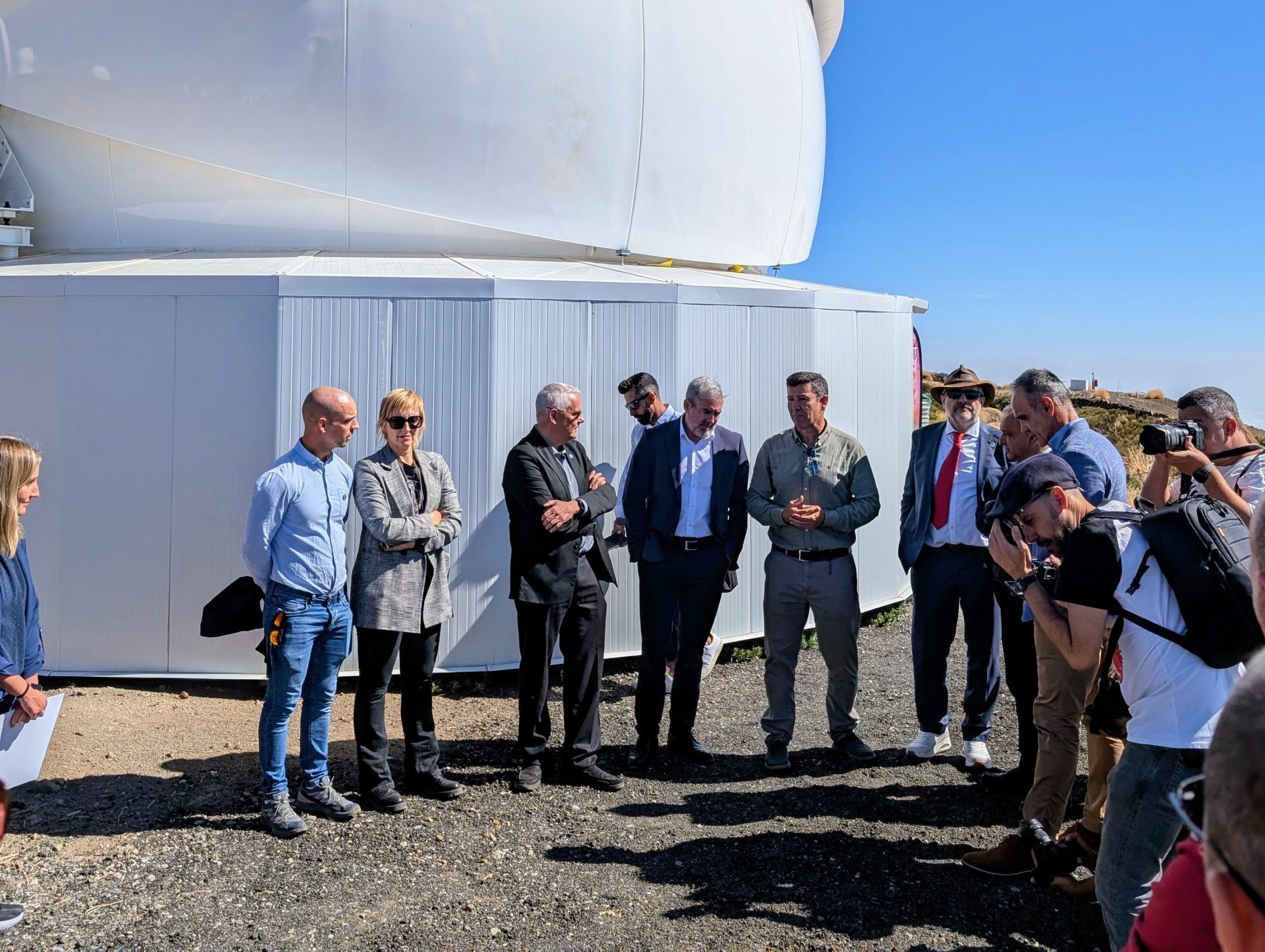The presentation at the Teide Observatory marks a milestone in private financed scientific infrastructures, bringing together leading figures in public research, innovation, and the Canary Islands’ government.

October 10, 2025. Canary-based company Light Bridges has presented what its co-founder Antonio Maudes calls “a dream 25 years in the making”: the Two-meter Twin Telescope (TTT) — the largest privately built and financed astronomical infrastructure in Spain, now operating at the Teide Observatory in Tenerife.
Equipped with the world’s largest fully-robotic system, the TTT represents a major leap in astrophysical research, having already contributed to more than twenty peer-reviewed papers, like the observation of a “minimoon” asteroid 2024 PT5 and the interstellar comet 3I/ATLAS, while preparing to lead upcoming studies on ultradiffuse galaxies, gravitational lenses and exoplanets.
“The TTT demonstrates that we can turn fiscal advantages into science, innovation, and high-quality employment,” said Antonio Maudes, co-founder and partner at Light Bridges. “It prepares us for the next generation of large telescopes and technologies, from space monitoring to optical and quantum communications.”
A New Milestone for Science and Industry in the Canary Islands
The presentation, held at the Teide Observatory, brought together leading scientific and institutional representatives, including Fernando Clavijo, President of the Canary Islands, and Migdalia Machín, Minister of the Canary Islands Government fo Universities, Science, Innovation and Culture.
President Clavijo emphasized the strategic value of the Canary Islands’ fiscal regime for fostering innovation: “Thanks to the fiscal framework of the Canary Islands, the private sector is beginning to generate economic value through science,” he said. “This marks a turning point in how the Canary Investment Reserve (RIC) and the Canary Islands Economic and Fiscal Regime (REF) can drive a new knowledge-based economy.”
Fernando Clavijo: “This marks a turning point in how the Canary Investment Reserve (RIC) and the Canary Islands Economic and Fiscal Regime (REF) can drive a new knowledge-based economy”
The TTT project has benefited from the RIC, ZEC, and 0% IGIC for space and astronomy, allowing 25% of observation time to be allocated to the Spanish astronomy community through the Instituto de Astrofísica de Canarias (IAC), while the remaining 75% is managed by Light Bridges through partnerships with international or national universities and research consortia, primarily in the United States, Canada and Asia.
Scientific Excellence and Collaboration
Since achieving “first light” in February 2025, the TTT has already produced ten scientific publications, surpassing the output of the Liverpool Telescope over two years. Its design integrates smaller optical units to achieve the effective power of a two-metre aperture, with a pointing precision of five arcseconds and tracking accuracy of around five meters.
“After first light, the TTT located an asteroid that almost became Earth’s second minimoon, and later measured the rotation of the interstellar comet 3I/ATLAS,” noted Miquel Serra-Ricart, astronomer and head of the Light Bridges scientific team. “These milestones confirm the telescope’s extraordinary precision and versatility.”
Since achieving “first light” in February 2025, the TTT has already produced ten scientific publications, surpassing the output of the Liverpool Telescope over two years
Valentín Martínez Pillet, Director of the IAC, described the installation as “a symbol of the Teide Observatory’s capacity for growth,” adding that the site “is becoming a world-class example of scientific infrastructure capable of operating across all wavelengths, from radio to Cherenkov light.”
Beyond Astronomy: A Strategic Platform for Space Technology
The Two-Meter Twin Telescope goes far beyond traditional astronomical research. Its advanced robotic and optical architecture positions it as a strategic platform for cutting-edge applications such as satellite and space debris tracking, planetary defense, space mining and the development of optical and quantum communication systems.
By combining scientific precision with technological innovation, the TTT strengthens Europe’s capacity to monitor and secure near-Earth space, while enabling experiments in data transmission and secure communication from ground to orbit.
Antonio Maudes: “The TTT allows us to explore the universe while creating practical capabilities that will define the future of the space industry — from deep-sky research to real-time orbital awareness”
“Our goal has always been to bridge science and technology,” explained Maudes. “The TTT allows us to explore the universe while creating practical capabilities that will define the future of the space industry — from deep-sky research to real-time orbital awareness.”
A Platform for the Future of Space Science
The TTT operates two 80 cm twin telescopes and two 2-meter instruments working in the visible and near-infrared ranges. It has already captured high-resolution images of the Crab Nebula and the Whirlpool Galaxy.
Beyond its initial discoveries, the TTT will enable detailed studies of metallic asteroids, supernova remnants, and spiral galaxy dynamics, while advancing the detection and characterization of exoplanets in red dwarf systems — key to understanding the formation of habitable worlds.
“This is just the beginning,” concluded Maudes. “Light Bridges was born from a vision of serving science by combining entrepreneurship with economic and legal research. The Two-meter Twin Telescope embodies this vision, expanding our understanding of the cosmos while paving the way for future innovation in the Canary Islands and beyond.”


